VOLKSWAGEN CORRADO 1990 Repair Manual
Manufacturer: VOLKSWAGEN, Model Year: 1990, Model line: CORRADO, Model: VOLKSWAGEN CORRADO 1990Pages: 906, PDF Size: 6.56 MB
Page 301 of 906
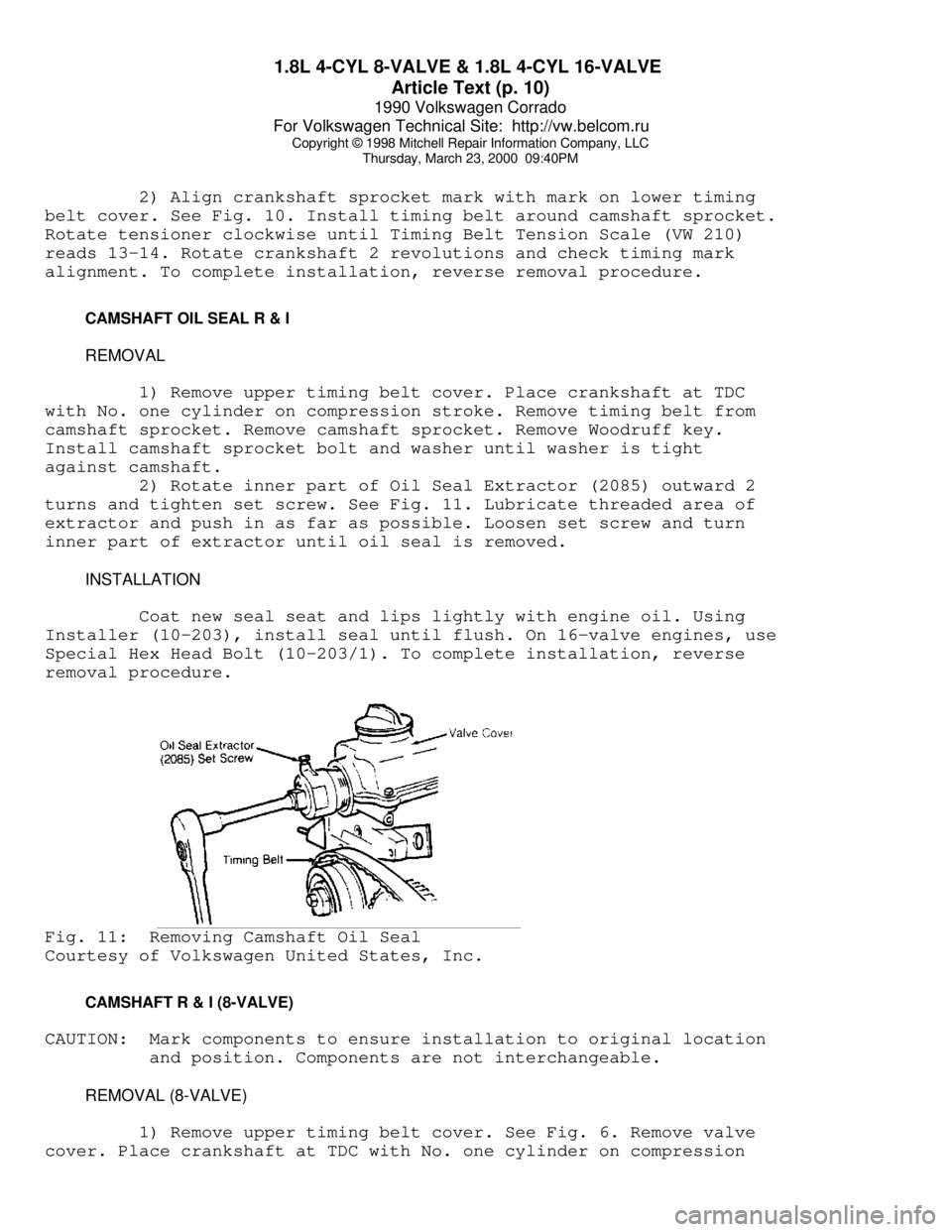
1.8L 4-CYL 8-VALVE & 1.8L 4-CYL 16-VALVE
Article Text (p. 10)
1990 Volkswagen Corrado
For Volkswagen Technical Site: http://vw.belcom.ru
Copyright © 1998 Mitchell Repair Information Company, LLC
Thursday, March 23, 2000 09:40PM
2) Align crankshaft sprocket mark with mark on lower timing
belt cover. See Fig. 10. Install timing belt around camshaft sprocket.
Rotate tensioner clockwise until Timing Belt Tension Scale (VW 210)
reads 13-14. Rotate crankshaft 2 revolutions and check timing mark
alignment. To complete installation, reverse removal procedure.
CAMSHAFT OIL SEAL R & I
REMOVAL
1) Remove upper timing belt cover. Place crankshaft at TDC
with No. one cylinder on compression stroke. Remove timing belt from
camshaft sprocket. Remove camshaft sprocket. Remove Woodruff key.
Install camshaft sprocket bolt and washer until washer is tight
against camshaft.
2) Rotate inner part of Oil Seal Extractor (2085) outward 2
turns and tighten set screw. See Fig. 11. Lubricate threaded area of
extractor and push in as far as possible. Loosen set screw and turn
inner part of extractor until oil seal is removed.
INSTALLATION
Coat new seal seat and lips lightly with engine oil. Using
Installer (10-203), install seal until flush. On 16-valve engines, use
Special Hex Head Bolt (10-203/1). To complete installation, reverse
removal procedure.Fig. 11: Removing Camshaft Oil Seal
Courtesy of Volkswagen United States, Inc.
CAMSHAFT R & I (8-VALVE)
CAUTION: Mark components to ensure installation to original location
and position. Components are not interchangeable.
REMOVAL (8-VALVE)
1) Remove upper timing belt cover. See Fig. 6. Remove valve
cover. Place crankshaft at TDC with No. one cylinder on compression
Page 302 of 906
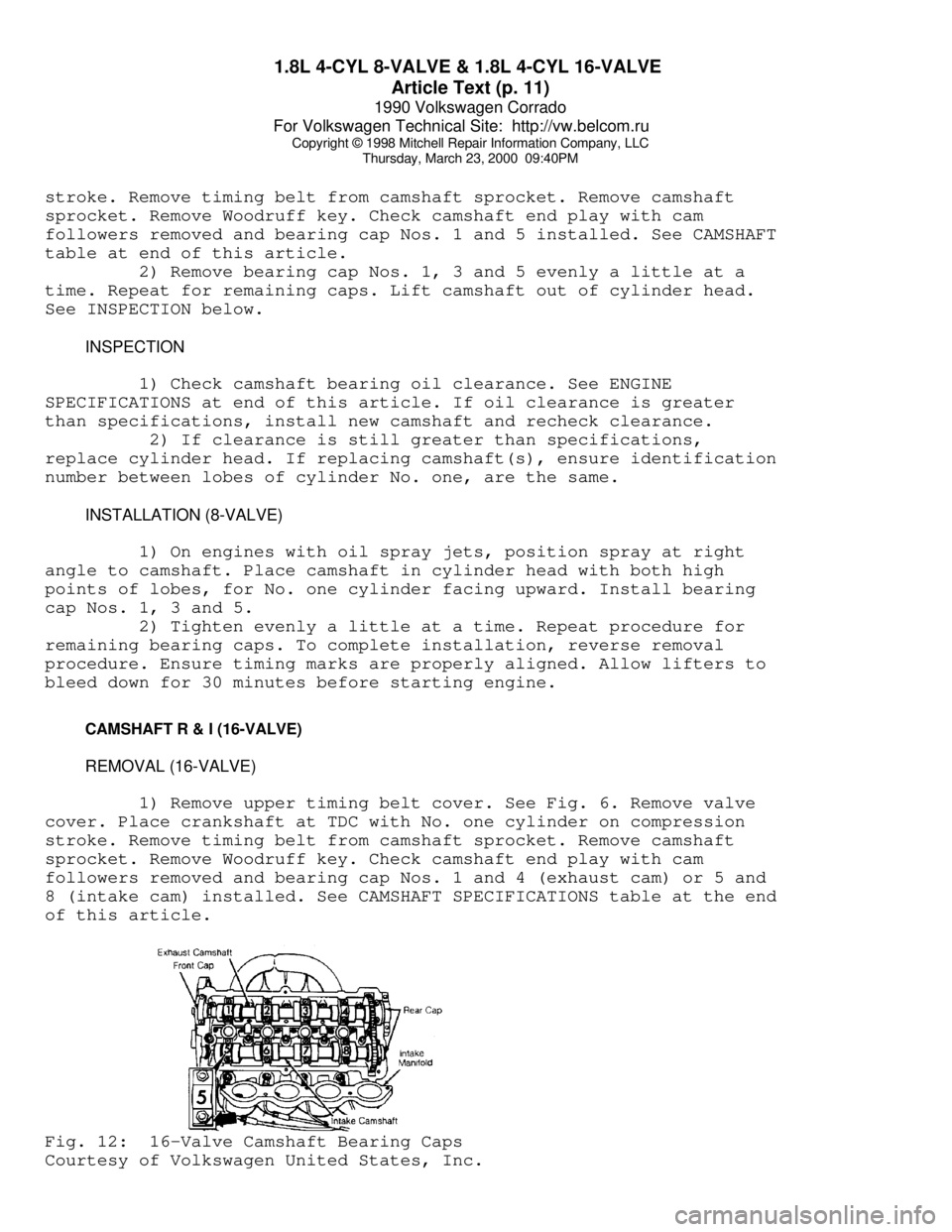
1.8L 4-CYL 8-VALVE & 1.8L 4-CYL 16-VALVE
Article Text (p. 11)
1990 Volkswagen Corrado
For Volkswagen Technical Site: http://vw.belcom.ru
Copyright © 1998 Mitchell Repair Information Company, LLC
Thursday, March 23, 2000 09:40PM
stroke. Remove timing belt from camshaft sprocket. Remove camshaft
sprocket. Remove Woodruff key. Check camshaft end play with cam
followers removed and bearing cap Nos. 1 and 5 installed. See CAMSHAFT
table at end of this article.
2) Remove bearing cap Nos. 1, 3 and 5 evenly a little at a
time. Repeat for remaining caps. Lift camshaft out of cylinder head.
See INSPECTION below.
INSPECTION
1) Check camshaft bearing oil clearance. See ENGINE
SPECIFICATIONS at end of this article. If oil clearance is greater
than specifications, install new camshaft and recheck clearance.
2) If clearance is still greater than specifications,
replace cylinder head. If replacing camshaft(s), ensure identification
number between lobes of cylinder No. one, are the same.
INSTALLATION (8-VALVE)
1) On engines with oil spray jets, position spray at right
angle to camshaft. Place camshaft in cylinder head with both high
points of lobes, for No. one cylinder facing upward. Install bearing
cap Nos. 1, 3 and 5.
2) Tighten evenly a little at a time. Repeat procedure for
remaining bearing caps. To complete installation, reverse removal
procedure. Ensure timing marks are properly aligned. Allow lifters to
bleed down for 30 minutes before starting engine.
CAMSHAFT R & I (16-VALVE)
REMOVAL (16-VALVE)
1) Remove upper timing belt cover. See Fig. 6. Remove valve
cover. Place crankshaft at TDC with No. one cylinder on compression
stroke. Remove timing belt from camshaft sprocket. Remove camshaft
sprocket. Remove Woodruff key. Check camshaft end play with cam
followers removed and bearing cap Nos. 1 and 4 (exhaust cam) or 5 and
8 (intake cam) installed. See CAMSHAFT SPECIFICATIONS table at the end
of this article.Fig. 12: 16-Valve Camshaft Bearing Caps
Courtesy of Volkswagen United States, Inc.
Page 303 of 906
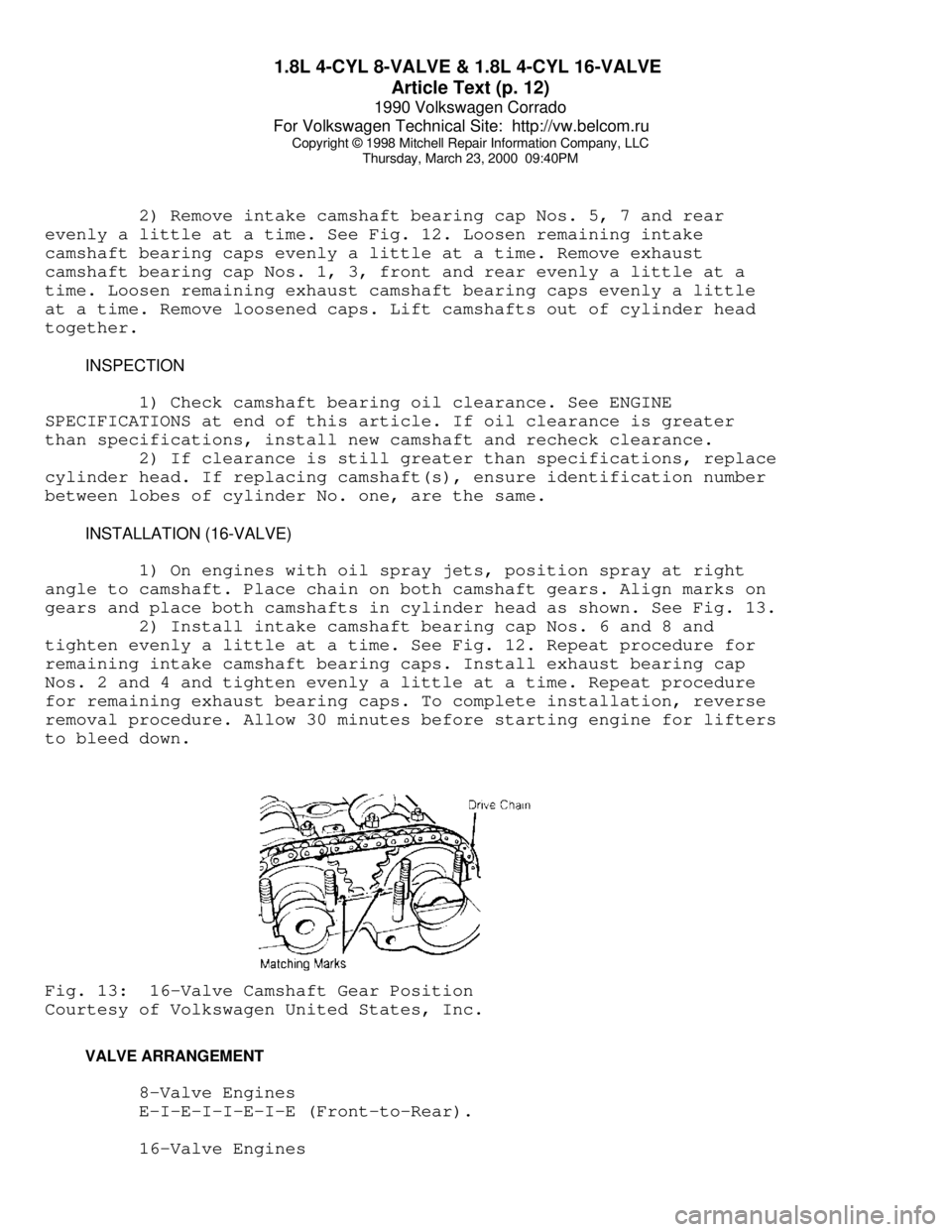
1.8L 4-CYL 8-VALVE & 1.8L 4-CYL 16-VALVE
Article Text (p. 12)
1990 Volkswagen Corrado
For Volkswagen Technical Site: http://vw.belcom.ru
Copyright © 1998 Mitchell Repair Information Company, LLC
Thursday, March 23, 2000 09:40PM
2) Remove intake camshaft bearing cap Nos. 5, 7 and rear
evenly a little at a time. See Fig. 12. Loosen remaining intake
camshaft bearing caps evenly a little at a time. Remove exhaust
camshaft bearing cap Nos. 1, 3, front and rear evenly a little at a
time. Loosen remaining exhaust camshaft bearing caps evenly a little
at a time. Remove loosened caps. Lift camshafts out of cylinder head
together.
INSPECTION
1) Check camshaft bearing oil clearance. See ENGINE
SPECIFICATIONS at end of this article. If oil clearance is greater
than specifications, install new camshaft and recheck clearance.
2) If clearance is still greater than specifications, replace
cylinder head. If replacing camshaft(s), ensure identification number
between lobes of cylinder No. one, are the same.
INSTALLATION (16-VALVE)
1) On engines with oil spray jets, position spray at right
angle to camshaft. Place chain on both camshaft gears. Align marks on
gears and place both camshafts in cylinder head as shown. See Fig. 13.
2) Install intake camshaft bearing cap Nos. 6 and 8 and
tighten evenly a little at a time. See Fig. 12. Repeat procedure for
remaining intake camshaft bearing caps. Install exhaust bearing cap
Nos. 2 and 4 and tighten evenly a little at a time. Repeat procedure
for remaining exhaust bearing caps. To complete installation, reverse
removal procedure. Allow 30 minutes before starting engine for lifters
to bleed down.Fig. 13: 16-Valve Camshaft Gear Position
Courtesy of Volkswagen United States, Inc.
VALVE ARRANGEMENT
8-Valve Engines
E-I-E-I-I-E-I-E (Front-to-Rear).
16-Valve Engines
Page 304 of 906
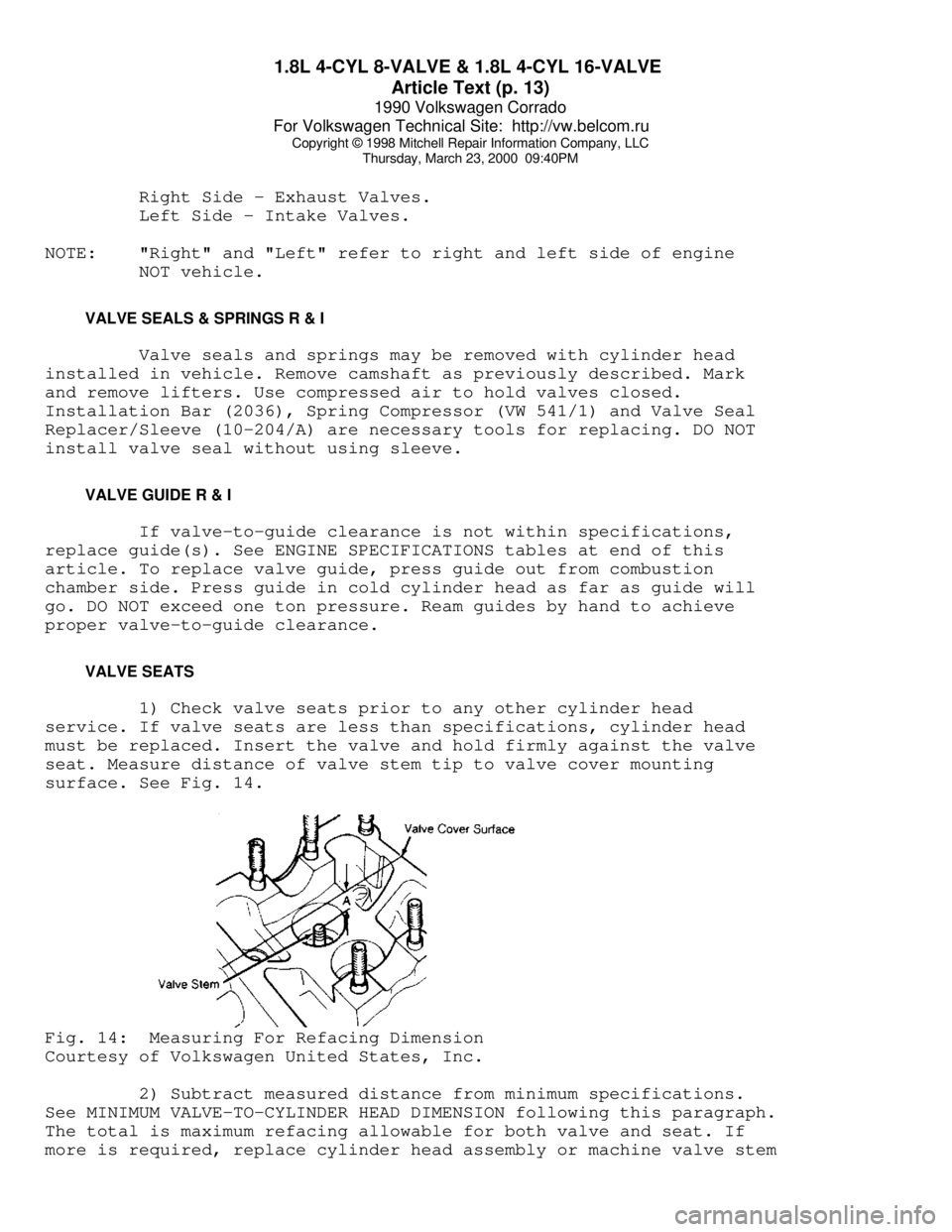
1.8L 4-CYL 8-VALVE & 1.8L 4-CYL 16-VALVE
Article Text (p. 13)
1990 Volkswagen Corrado
For Volkswagen Technical Site: http://vw.belcom.ru
Copyright © 1998 Mitchell Repair Information Company, LLC
Thursday, March 23, 2000 09:40PM
Right Side - Exhaust Valves.
Left Side - Intake Valves.
NOTE: "Right" and "Left" refer to right and left side of engine
NOT vehicle.
VALVE SEALS & SPRINGS R & I
Valve seals and springs may be removed with cylinder head
installed in vehicle. Remove camshaft as previously described. Mark
and remove lifters. Use compressed air to hold valves closed.
Installation Bar (2036), Spring Compressor (VW 541/1) and Valve Seal
Replacer/Sleeve (10-204/A) are necessary tools for replacing. DO NOT
install valve seal without using sleeve.
VALVE GUIDE R & I
If valve-to-guide clearance is not within specifications,
replace guide(s). See ENGINE SPECIFICATIONS tables at end of this
article. To replace valve guide, press guide out from combustion
chamber side. Press guide in cold cylinder head as far as guide will
go. DO NOT exceed one ton pressure. Ream guides by hand to achieve
proper valve-to-guide clearance.
VALVE SEATS
1) Check valve seats prior to any other cylinder head
service. If valve seats are less than specifications, cylinder head
must be replaced. Insert the valve and hold firmly against the valve
seat. Measure distance of valve stem tip to valve cover mounting
surface. See Fig. 14.Fig. 14: Measuring For Refacing Dimension
Courtesy of Volkswagen United States, Inc.
2) Subtract measured distance from minimum specifications.
See MINIMUM VALVE-TO-CYLINDER HEAD DIMENSION following this paragraph.
The total is maximum refacing allowable for both valve and seat. If
more is required, replace cylinder head assembly or machine valve stem
Page 305 of 906

1.8L 4-CYL 8-VALVE & 1.8L 4-CYL 16-VALVE
Article Text (p. 14)
1990 Volkswagen Corrado
For Volkswagen Technical Site: http://vw.belcom.ru
Copyright © 1998 Mitchell Repair Information Company, LLC
Thursday, March 23, 2000 09:40PM
(Cabriolet only). If less than minimum dimension is used, valve
lifters will not function.
MINIMUM VALVE-TO-CYLINDER HEAD DIMENSIONÄÄÄÄÄÄÄÄÄÄÄÄÄÄÄÄÄÄÄÄÄÄÄÄÄÄÄÄÄÄÄÄÄÄÄÄÄÄÄÄÄÄÄÄÄApplication In. (mm)
8-Valve
Intake Valve .............. 1.330 (33.78)
Exhaust Valve ............. 1.342 (34.09)
16-Valve
Intake Valve .............. 1.354 (34.39)
Exhaust Valve ............. 1.366 (34.70)
ÄÄÄÄÄÄÄÄÄÄÄÄÄÄÄÄÄÄÄÄÄÄÄÄÄÄÄÄÄÄÄÄÄÄÄÄÄÄÄÄÄÄÄÄÄ VALVES
1) With valves removed, measure dimension of valves. If not
within specifications, replace valves. DO NOT reface exhaust valves
with machine. Lap valves by hand or replace as necessary. See ENGINE
SPECIFICATIONS at end of this article.
CAUTION: On 16-valve engines, exhaust valves are sodium filled. Use
following procedure to dispose of valves properly.
2) To dispose of sodium filled valves, cut valve stem off
near head of valve with hacksaw. DO NOT allow water to contact valve
during cutting. Throw valve stem in bucket of water and move quickly
away. Once reaction with water has ceased, discard valve. Repeat
procedure as necessary.
VALVE CLEARANCE ADJUSTMENT
NOTE: Cylinder heads without shims between camshaft(s) and lifters
are not adjustable. See LIFTERS under VALVES in this article.
1) After any cylinder head repair, check and adjust valves
with engine cold. After 1000 miles (after repair) or at normal service
interval, adjust with engine warm. Shims are available in different
thicknesses. Etched side of shim must be installed away from camshaft.
2) Position camshaft lobes of cylinder to be check with high
points facing upward (valves closed). Measure clearance. See VALVE
ADJUSTMENT SPECIFICATIONS table in this article. If clearance cannot
be achieved with thinnest shim, shorter valves may be installed. If
clearance is greater than specifications, use appropriate shim to
acquire proper clearance.
3) To remove shim, rotate lifter (follower) so grooves face
inward towards each other (one cylinder at a time). Using Lifter
Compressor (2078) and Pliers (10-208), remove shim. To install,
reverse removal procedure.
Page 306 of 906
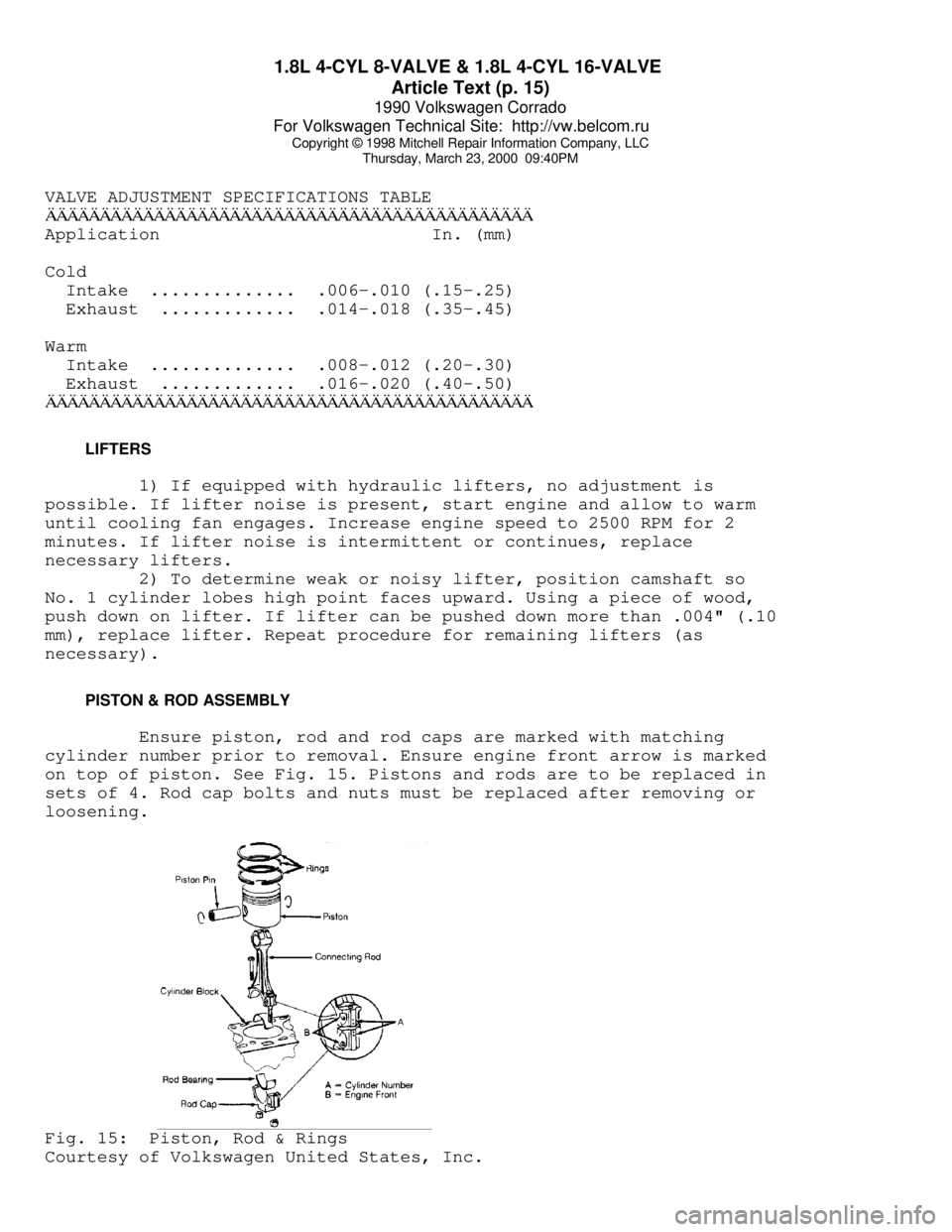
1.8L 4-CYL 8-VALVE & 1.8L 4-CYL 16-VALVE
Article Text (p. 15)
1990 Volkswagen Corrado
For Volkswagen Technical Site: http://vw.belcom.ru
Copyright © 1998 Mitchell Repair Information Company, LLC
Thursday, March 23, 2000 09:40PM
VALVE ADJUSTMENT SPECIFICATIONS TABLEÄÄÄÄÄÄÄÄÄÄÄÄÄÄÄÄÄÄÄÄÄÄÄÄÄÄÄÄÄÄÄÄÄÄÄÄÄÄÄÄÄÄÄÄÄApplication In. (mm)
Cold
Intake .............. .006-.010 (.15-.25)
Exhaust ............. .014-.018 (.35-.45)
Warm
Intake .............. .008-.012 (.20-.30)
Exhaust ............. .016-.020 (.40-.50)
ÄÄÄÄÄÄÄÄÄÄÄÄÄÄÄÄÄÄÄÄÄÄÄÄÄÄÄÄÄÄÄÄÄÄÄÄÄÄÄÄÄÄÄÄÄ LIFTERS
1) If equipped with hydraulic lifters, no adjustment is
possible. If lifter noise is present, start engine and allow to warm
until cooling fan engages. Increase engine speed to 2500 RPM for 2
minutes. If lifter noise is intermittent or continues, replace
necessary lifters.
2) To determine weak or noisy lifter, position camshaft so
No. 1 cylinder lobes high point faces upward. Using a piece of wood,
push down on lifter. If lifter can be pushed down more than .004" (.10
mm), replace lifter. Repeat procedure for remaining lifters (as
necessary).
PISTON & ROD ASSEMBLY
Ensure piston, rod and rod caps are marked with matching
cylinder number prior to removal. Ensure engine front arrow is marked
on top of piston. See Fig. 15. Pistons and rods are to be replaced in
sets of 4. Rod cap bolts and nuts must be replaced after removing or
loosening.Fig. 15: Piston, Rod & Rings
Courtesy of Volkswagen United States, Inc.
Page 307 of 906

1.8L 4-CYL 8-VALVE & 1.8L 4-CYL 16-VALVE
Article Text (p. 16)
1990 Volkswagen Corrado
For Volkswagen Technical Site: http://vw.belcom.ru
Copyright © 1998 Mitchell Repair Information Company, LLC
Thursday, March 23, 2000 09:40PM
FITTING PISTONS & RINGS
1) DO NOT measure clearances with cylinder block mounted on
an engine stand. Check clearance of piston-to-cylinder bore. Piston
diameter is stamped on top of piston in millimeters. Arrow on top of
piston faces front of engine.
PISTON-TO-CYLINDER BORE DIMENSIONSÄÄÄÄÄÄÄÄÄÄÄÄÄÄÄÄÄÄÄÄÄÄÄÄÄÄÄÄÄÄÄÄÄÄÄÄÄÄÄÄÄÄÄÄÄÄÄÄÄÄÄÄÄÄÄ Piston Diameter Cylinder Bore
Size In. (mm) In. (mm)
Standard ....... 3.188 (80.98) ...... 3.189 (81.01)
1st Over ....... 3.198 (81.23) ...... 3.199 (81.26)
2nd Over ....... 3.208 (81.48) ...... 3.209 (81.51)
ÄÄÄÄÄÄÄÄÄÄÄÄÄÄÄÄÄÄÄÄÄÄÄÄÄÄÄÄÄÄÄÄÄÄÄÄÄÄÄÄÄÄÄÄÄÄÄÄÄÄÄÄÄÄÄ 2) Measure ring end gap. Measure ring side clearance with
piston. If not within specifications, replace as necessary. See ENGINE
SPECIFICATIONS at end of this article. Install rings on piston with
"TOP" mark facing upward. Recessed edge on outside of center ring must
face piston pin (down). Position ring ends as shown. See Fig. 15.Fig. 16: Exploded View of Crankshaft Assembly
Courtesy of Volkswagen United States, Inc.
Page 308 of 906

1.8L 4-CYL 8-VALVE & 1.8L 4-CYL 16-VALVE
Article Text (p. 17)
1990 Volkswagen Corrado
For Volkswagen Technical Site: http://vw.belcom.ru
Copyright © 1998 Mitchell Repair Information Company, LLC
Thursday, March 23, 2000 09:40PM
PISTON PIN REPLACEMENT R & I
Ensure piston and rod are properly marked. Remove both
circlips from pin bore groove. Use Piston Pin Replacer (VW 207C) to
remove and install the piston pin. If pin is too tight, heat piston to
140øF (60øC). To install, reverse removal procedure. Ensure rod is
properly positioned with piston. See Fig. 15.
CRANKSHAFT R & I
1) Using flywheel Holder (10-201), remove flywheel bolts.
Remove flywheel. Remove front and rear oil seals and covers. Remove
connecting rod bearing caps.
2) Measure crankshaft end play. See CRANKSHAFT END PLAY CHECK
in this article. Remove main bearing cap bolts. Remove main bearing
caps. Remove crankshaft. To install, reverse removal procedure.
MAIN BEARING INSTALLATION
Main bearing caps are marked with matching journal and must
be installed to original position. See Fig. 16. Thrust bearing is
located at No. 3 main bearing cap. Use Plastigage method to check
clearance. Machine or replace as necessary. See ENGINE SPECIFICATIONS
at end of this article. Tighten evenly to specifications in several
steps.
CONNECTING ROD BEARING INSTALLATION
Ensure rod caps are marked to ensure installation to original
position and location. Use Plastigage to measure bearing clearances.
Measure connecting rod side play. Replace or machine as necessary. See
ENGINE SPECIFICATIONS at end of this article. Tighten evenly to
specifications in several steps.
CRANKSHAFT END PLAY CHECK
Insert feeler gauge between No. 3 main bearing and crankshaft
thrust face to measure end play. See Fig. 16. Replace thrust bearing
as necessary. See ENGINE SPECIFICATIONS at end of this article.
Original thrust bearing uses plain shell with 4 separate washers and
replacements have attached collar.
REAR MAIN BEARING OIL SEAL R & I
Remove flywheel/flex plate and discard retaining bolts. Oil
seal may removed without removing retaining flange by prying seal out.
Remove retaining flange if gasket is leaking. See Fig. 16. If
installing without removing retaining flange, use Centering Tool
(2003/2A) to center seal and Installer (2003/1) to install seal.
Page 309 of 906

1.8L 4-CYL 8-VALVE & 1.8L 4-CYL 16-VALVE
Article Text (p. 18)
1990 Volkswagen Corrado
For Volkswagen Technical Site: http://vw.belcom.ru
Copyright © 1998 Mitchell Repair Information Company, LLC
Thursday, March 23, 2000 09:40PM
Install new flywheel bolts.
FRONT COVER OIL SEAL R & I
REMOVAL
Remove timing belt. See REMOVAL under TIMING BELT R & I in
this article. Rotate inner part of Oil Seal Extractor (2085) outward 2
turns and tighten set screw. See Fig. 11. Lubricate threaded area of
extractor and push in as far as possible. Loosen set screw and turn
inner part of extractor until oil seal is removed.
INSTALLATION
Lubricate outer edge and lip of new seal. Place guide sleeve
from Seal Installer (3083) onto crankshaft. Push oil seal over guide
sleeve. Press seal completely into position. To complete installation,
reverse removal procedure.
INTERMEDIATE SHAFT ASSEMBLY
Remove timing belt. See REMOVAL under TIMING BELT in this
article. Mark distributor assembly for installation reference and
remove distributor assembly. Check intermediate shaft end play. See
INTERMEDIATE SHAFT END PLAY SPECIFICATION table following this
paragraph. Remove intermediate shaft sprocket. Remove intermediate
shaft seal flange. Replace seal (if necessary). To install, reverse
removal procedure. See ENGINE SPECIFICATIONS at end of this article.
INTERMEDIATE SHAFT END PLAY SPECIFICATIONÄÄÄÄÄÄÄÄÄÄÄÄÄÄÄÄÄÄÄÄÄÄÄÄÄÄÄÄÄÄÄÄÄÄÄÄÄÄÄÄÄÄÄÄÄApplication In. (mm)
1.8L ........................... .010 (.25)
ÄÄÄÄÄÄÄÄÄÄÄÄÄÄÄÄÄÄÄÄÄÄÄÄÄÄÄÄÄÄÄÄÄÄÄÄÄÄÄÄÄÄÄÄÄ CYLINDER BLOCK INSPECTION
DO NOT measure cylinder block while mounted on an engine
stand. Inaccurate measurements may be achieved. Check cylinder bore
for wear, out-of-round and taper. Pistons are available in oversize.
Cylinder block bore may be machined. Check cylinder block for warpage.
See ENGINE SPECIFICATIONS at end of this article.
ENGINE OILING SYSTEM SPECIFICATIONS
CRANKCASE CAPACITY
CRANKCASE CAPACITY TABLE
ÄÄÄÄÄÄÄÄÄÄÄÄÄÄÄÄÄÄÄÄÄÄÄÄÄÄÄÄÄÄÄÄÄÄÄÄÄÄÄÄÄÄÄÄÄÄÄÄÄÄÄÄÄÄÄ With Filter Without Filter
Page 310 of 906

1.8L 4-CYL 8-VALVE & 1.8L 4-CYL 16-VALVE
Article Text (p. 19)
1990 Volkswagen Corrado
For Volkswagen Technical Site: http://vw.belcom.ru
Copyright © 1998 Mitchell Repair Information Company, LLC
Thursday, March 23, 2000 09:40PM
Model Replacement Replacement
Fox ........... 3.7 Qts. (3.5L) . 3.2 Qts. (3.0L)
All Others .... 4.3 Qts. (4.1L) . 4.7 Qts. (4.5L)ÄÄÄÄÄÄÄÄÄÄÄÄÄÄÄÄÄÄÄÄÄÄÄÄÄÄÄÄÄÄÄÄÄÄÄÄÄÄÄÄÄÄÄÄÄÄÄÄÄÄÄÄÄÄÄ OIL PRESSURE
Minimum oil pressure at idle is 4.3 psi (.3 kg/cm
ý). Oil
pressure at 2000 RPM is 29 psi (2.0 kg/cm
ý).
OIL PAN REMOVAL
REMOVAL
Oil pan can be removed and installed with engine in vehicle.
No further information available from manufacturer.
OIL PUMP R & I
REMOVAL & INSTALLATION
Remove oil pan. Remove oil pump attaching bolts and remove
oil pump assembly. To install, reverse removal procedure.
INSPECTION
Check oil pump backlash and oil pump axial play. If not
within specifications, replace oil pump assembly. See OIL PUMP
SPECIFICATIONS table in this article.
OIL PUMP SPECIFICATIONS
ÄÄÄÄÄÄÄÄÄÄÄÄÄÄÄÄÄÄÄÄÄÄÄÄÄÄÄÄÄÄÄÄÄÄÄÄÄÄÄÄÄÄÄÄÄApplication In. (mm)
Backlash
New .......................... .002 (.05)
Limit ........................ .008 (.20)
Axial Play Limit ............... .006 (.15)
ÄÄÄÄÄÄÄÄÄÄÄÄÄÄÄÄÄÄÄÄÄÄÄÄÄÄÄÄÄÄÄÄÄÄÄÄÄÄÄÄÄÄÄÄÄ ENGINE COOLING SYSTEM
CAUTION: Coolant/water mixture should be used at all times. Only
ethylene glycol based (phosphate-free) antifreeze may be
used, as it protects aluminum/iron engines from corrosion.
BELT TENSION
Belt deflection with 22 lbs. (10 kg) pressure applied at
midpoint of longest belt run should be 3/8-9/16" (10-15mm).